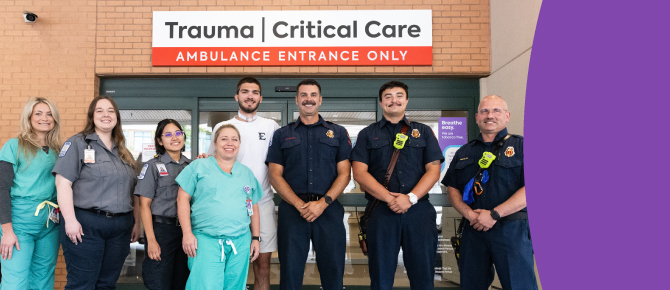
Ear, Nose & Throat (Otolaryngology)
Wellstar ear, nose and throat (ENT) doctors are also known as otolaryngologists. They help people live better lives by treating conditions that affect the head and neck.
Expert Ear, Nose & Throat Care
- Expert ENT Care
- Audiology
- Complex Pediatric ENT
- Facial Plastic Surgery
- Head & Neck Cancer
- Sinus Surgery
- Skull Base Multidisciplinary Program
- Sleep Surgery
Wellstar ear, nose and throat doctors (ENT) take care of people with hearing loss and infections and can also help you manage complex conditions. Our team has specialized training in almost all ENT specialties. If you or your children have any ear, nose or throat issues, visit one of our doctors to get the help you need.
Care that’s right for you
Wellstar ENTs provide excellent care during more than 45,000 visits each year. They make sure the care you receive is right for you. Some care plans may include medicine or surgery. Our ENTs typically work as part of a team including primary care providers, pediatricians or other specialists. We’d love to help you feel better.
Advanced surgical care
For some adults and children, surgery may be the best option. Our highly skilled surgeons have experience from thousands of procedures each year. We offer the latest techniques and technologies.
Patients have access to a full range of ear, nose and throat procedures at Wellstar. They include but are not limited to surgery for the thyroid, parathyroid, salivary gland, sinuses, middle ear, larynx, airway, skull base and complex pediatric conditions. Our program also offers hypoglossal nerve stimulator implants, facial plastic surgery and complex excision and reconstruction for head and neck cancer.
Audiologists are part of the team that cares for people with hearing and balance problems at Wellstar. Our tests help improve hearing and enhance the quality of life for newborns, children and adults. Testing and treatment plans are age-appropriate to make sure everyone gets the right care. We offer affordable prices for hearing aid services.
Learn more about comprehensive ear testing at Wellstar.
Some pediatric conditions related to the ear, nose and throat (ENT) can be more challenging to address. That’s why Wellstar has ENT doctors just for kids. Families can team up with these doctors to get the care their kids need.
We offer a thorough examination in a comfortable, family-friendly environment. We help children with infections, neck masses and other problems related to breathing, feeding, swallowing, hearing, sleeping, voice and speech.
Learn more about ENT care for complex pediatric conditions at Wellstar.
How you look and feel affects how you approach life. When you’re ready to achieve your ideal look, you deserve to have access to the best cosmetic doctors. Our dual board-certified facial surgeons have advanced training from top medical centers, and they stay current on the latest techniques and advances in the field.
Learn more about how Wellstar facial plastic surgeons help you look your best.
A high level of coordination is vital for patients with head and neck cancer to have the best outcomes. That's why our experienced head and neck cancer experts collaborate with other experts in multidisciplinary tumor boards, working together to diagnose, stage and treat your cancer. Accredited by the American College of Surgeons (ACS) Commission on Cancer (CoC), Wellstar provides comprehensive care for people with head and neck cancer.
Learn more about the high level of care provided for head and neck cancer at Wellstar.
If you have ongoing nose or sinus problems, Wellstar is here to help. Rhinologists—ear, nose and throat doctors with additional training in sinus care—diagnose and treat these issues so you can enjoy life more. We offer personalized care and the latest treatments.
Learn more about how rhinologists at Wellstar help people with advanced sinus surgery.
The evaluation and treatment of skull base disorders demand the expertise of a highly specialized team. These tumors and disorders affect the area between the sinuses, ear and brain. Skull base conditions are highly complex to treat, requiring multidisciplinary planning and the highest level of technical skill to preserve the important nerves and blood vessels in this area.
Learn about the highly specialized team that treats skull base tumors and disorders at Wellstar.
Your Wellstar ear, nose and throat (ENT) sleep surgeon specializes in airway surgery. They will design a personalized treatment plan to help children and adults with obstructive sleep apnea. Wellstar is one of the few groups offering surgeries for hypoglossal nerve stimulators like the Inspire implant.
Learn more about how sleep surgeons at Wellstar help people overcome obstructive sleep apnea.
Meet Our Team
Conditions We Treat
Ear conditions
- Dizziness
- Ear infections
- Hearing and balance disorders
- Perforation of the eardrum
- Cholesteatoma
Nose conditions
- Allergies
- Congestion
- Cosmetic problems
- Nasal growths and conditions
- Sinus conditions
- Sleep disorders
Throat conditions
- Breathing issues
- Cancers of the head and neck
- Infections
- Swallowing issues
- Snoring
- Thyroid and parathyroid conditions
- Tonsillitis
- Tumors
- Voice issues
Services We Offer
- Biopsies
- Balance testing
- Cochlear implants and bone anchored hearing aids
- Corrective breathing surgery
- Ear tube insertion
- Facial plastic surgery
- Hearing testing
- Hearing aid fitting
- Hypoglossal nerve stimulator implants (Inspire implant)
- Reconstructive ear surgery
- Reconstructive head and neck cancer surgery
- Skull base surgery
- Septoplasty
- Sinus surgery
- Sleep disorder surgery
- Tonsil and adenoid removal
- Tula Tubes
- Video laryngoscopy and nasal endoscopy








